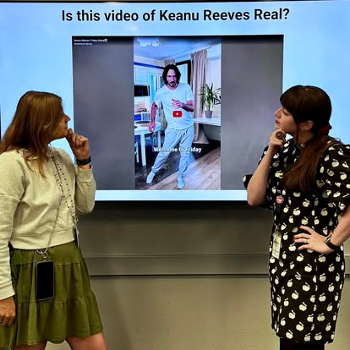AI-Generated Video and Media Literacy
Librarians’ news literacy lessons are vital to teaching students to identify AI and misinformation on social media.
When Molly Dettmann scrolls through her social media feeds, she sees teaching opportunities along with the posts. The Oklahoma high school librarian knows any viral video, inaccurate post, or AI slop is a chance for a media literacy lesson with her students.
“As a school librarian, it’s [my] job to help our students be information and news literate,” Dettmann says. “I’ve always done lessons looking at the news, viral social media posts, all of the media and information that they interact with, and discerning what’s real, what isn’t, what’s opinion.”
Dettmann is in her eighth year as a school librarian and has adapted her lessons with trends and technology. She uses the News Literacy Project (NLP), Project LookSharp, RumorGuard, and Developing Digital Detectives: Essential Lessons for Discerning Fact from Fiction in the ‘Fake News’ Era, a book by Darren Hudgins and Jennifer LaGarde, as her main resources.
 |
Molly Dettmann (right) and journalism teacher Gwynne Easley teach students to spot AI-generated video.
|
While recently working with a journalism class for a weeklong lesson on news literacy, she used NLP resources to help fact-check some viral videos, including one of bunnies jumping on a trampoline. While there are videos that are clearly AI-generated, it is often not so easy to discern reality from fiction just by looking at it.
“It just gets harder and harder,” says Dettmann. “But our kids are smart, and when you give them the skills and tools then it’s not hard for them to not fall for that misinformation.”
The technology has advanced, but the method for fact-checking really remains the same, says Alee Quick of NLP.
“It may seem really overwhelming, that it’s really high tech, but the solutions have been around for a long time,” says Quick, NLP’s director of community engagement. “There are some tools that we can teach kids that can help them take some of the power back.”
Early on in AI-generated images and video, people were told to look for visual clues like extra fingers, but as the technology progresses, it’s more difficult, according to Quick. NLP recommends a multi-step process.
- Vet sources. Look at where the information came from, who posted it, who is sharing it.
- Reverse image search. This isn’t just for still photos. A screenshot of a video can provide the image for a reverse image search to help find the original source of the material.
- Lateral reading. Open a new tab and search keywords to learn more about what the image or video is purporting to be. If it’s a disaster or supposed news event, it can be debunked quickly. For example, when videos of the Eiffel Tower on fire started circulating on social media, seeing that there were no news stories about something that, if real, would have generated massive news coverage, meant those videos were AI-generated.
Students also need to learn what makes a source credible, which requires looking at past posts and doing a little investigative work, as well as having learned the “key fundamentals of news literacy,” according to Quick, which means learning how journalists do their work, verify information, and fact-check.
Once students have these tools, Quick says, when they see something they suspect could be AI-generated, they will know how to find a source with a higher level of trust.
“We always say we don’t teach kids what to think, but rather how to think,” says Quick.
Back at Norman North High School in Norman, OK, Dettmann says the AI-generated images of disasters really hit home with students during discussions, but even looking at something that seems innocuous, like the trampoline bunnies video, sparked deeper conversations. What is the point of that video, she’ll ask? When students respond that they are being manipulated, they talk about whether that’s a good thing and what the motivations behind it are.
“Students did a really good job making those connections themselves, but it does take teaching it and looking through these examples with guidance to hit home with our teens,” she says. “We all could use some of these lessons.”
RELATED
The job outlook in 2030: Librarians will be in demand
The job outlook in 2030: Librarians will be in demand
ALREADY A SUBSCRIBER? LOG IN
We are currently offering this content for free. Sign up now to activate your personal profile, where you can save articles for future viewing






Add Comment :-
Be the first reader to comment.
Comment Policy:
Comment should not be empty !!!